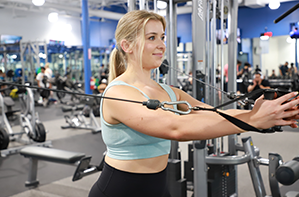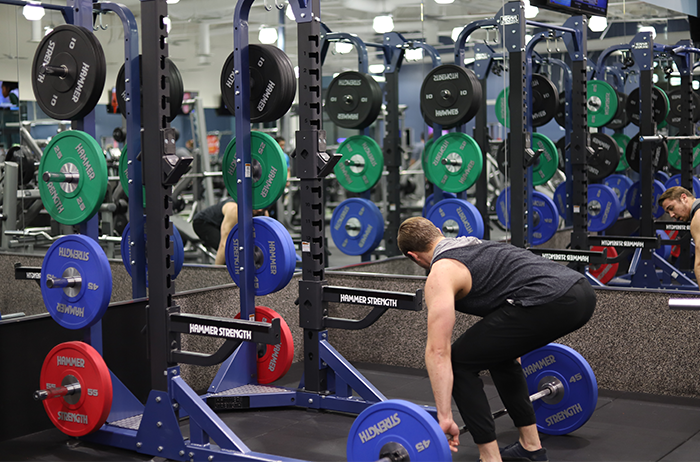- Blog
- How Often Should You Workout A Single Muscle Group?
- August 24, 2021 |
- Strength Training | Muscle Recovery
How Often Should You Workout A Single Muscle Group?
Some muscle groups can be difficult to work out, especially if you're not sure how often you should do it. It can be hard to know which muscle groups to prioritize with your workouts and how to create a “split” or workout program to focus on different muscle groups.
A “muscle group” is a term generally referring to a “group” or section of muscles on your body. For example, legs, arms, chest, shoulders and back are typically referred to when someone is speaking about working out different “muscle groups.”
Different workouts and workout programs can over-tax some of these muscle groups, which can lead to overtraining and a lack of proper muscle recovery. For this reason, many people who are interested in building muscle and strength will divide their workouts into muscle group “splits.”
Muscle group splits are one way to make working out easier on yourself and your muscles. Splits allow you to focus on just one muscle group per workout so that you don't have to worry about overtraining or neglecting any of your muscle groups in favor of others. It also allows you to continue to work out a different muscle group while one muscle group is recovering with muscle soreness.
 How Often Should You Workout?
How Often Should You Workout?
According to experts, it's recommended to take 48-72 hours of recovery between resistance training sessions. It's been proven to optimize molecular response to gains in muscle size and strength, while allowing enough time for proper muscle recovery.
After a whole day of work or school, you're probably exhausted and don't want to do any more extra movements than necessary for your muscles. So instead of doing your entire body on one day, you can work out a different muscle group every other day. You have to make your workouts somewhat enjoyable right?
Also, this way you give your muscles enough time to recover fully between their workouts so that they don't become overworked and at risk of overtraining.
Training Frequency
Training frequency defines the number of workouts per week that you'll have. Muscle groups can be trained 3-5 times a week depending on your goals, time availability, and the intensity of the workout.
Muscle groups are important for a healthy body and mind, but it can be hard to keep up with them. Muscle groups need time to rest so they don't become overworked or tired. Muscle group splits allow you to focus on one muscle group at a time, which is easier than working out your whole body every day.
Muscle groups need 48-72 hours of recovery after resistance training sessions. Remember that the molecular response will be optimized, and muscle size and strength will increase better when workouts of the same muscle group are separated by 48-72 hours.
Read More: Is 72 hours Enough for Muscle Recovery?

ACSM Frequency Recommendations:
American College of Sports Medicine created evidence-based recommendations on how frequently you should work out. Here are their recommendations:
Resistance Exercises:
Each muscle group should be trained 2 to 3 days per week with at least 48 hours separating the same muscle group. For example, if you worked out your legs on Monday, you'd have to wait until at least Wednesday before working out those muscles again.
Aerobic Exercises:
5 days per week of moderate exercise, or 3 days per week of vigorous exercise, or 3 to 5 days of a combination of moderate and vigorous exercise.
Flexibility Exercises:
2 to 3 days per week with daily being most effective.
Workout Splits
Splits are important for a variety of reasons.
Muscle groups need time off after working out, so it's good to take appropriate rest before working out the same muscle group again. Another advantage of splits is that they make your workouts easier and more enjoyable since you don't have to do as much movement in one day.
Setting up your weekly workout schedule will be easier too since you've split your workouts into different days.
 Our Favorite Workout Splits
Our Favorite Workout Splits
Here are two of our favorite workout splits you can start implementing today.
Push/Pull/Legs
The push/pull/legs workout split is great for overall fitness. Muscle groups are divided into three different workouts.
The push workouts: Chest, Shoulder, and Triceps
The pull workouts: Back and Biceps
The legs workouts: Legs and Core
Push/Pull/Legs Weekly Workout Structure:
Monday: Push Workouts
Tuesday: Pull Workouts
Wednesday: Legs & Core
Thursday: Push Workout
Friday: Pull Workouts
Saturday: Legs & Core
Sunday: Rest Day
You notice how you're able to hit your muscle groups twice a week while still allowing 48 to 72 hours of the adequate rest period.
 The 5 Day Split
The 5 Day Split
The 5-day split is ideal for someone who is at an intermediate and advanced level. Muscle groups are split into 5 workouts over the weekdays.
5 Day Split Weekly Workout Structure
Monday: Back
Tuesday: Chest
Wednesday: Arms
Thursday: Shoulders
Friday: Legs & Core
Saturday: Rest
Sunday: Rest
For the 5 day split, you can always mix things up. You don't have to necessarily go in that order.
Conclusion
If you're planning on the workout, be sure you know what splits and workouts will work for your body. Muscle groups need time to recover and grow after working out again. Muscle group splits allow you to focus on one muscle group at a time causing maximum growth while also allowing 48-72 hour rest periods before hitting the same muscle group again.
Creating a plan and executing that plan will get you in shape and build a solid fitness foundation. Don't forget to try those workout splits and let us know if you liked them.
Need help with training? Make sure to contact one of our certified personal trainers. With hard work and dedication, we'll make your workouts more efficient, enjoyable, and productive. Stay strong!
Citations:
Yang, Yifan et al. “Effects of Consecutive Versus Non-consecutive Days of Resistance Training on Strength, Body Composition, and Red Blood Cells.” Frontiers in physiology vol. 9 725. 18 Jun. 2018, doi:10.3389/fphys.2018.00725
American College of Sports Medicine. (2017). ACSM’s guidelines for exercise testing and prescription (10th ed.). Lippincott Williams and Wilkins.
Sign Up for a Free 3-Day Guest Pass!
No commitment is necessary.